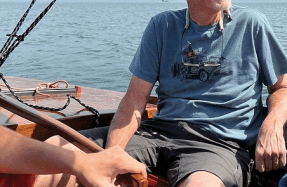Following Flinders

After a hard 33-day crossing in the Roaring Forties from Cape Town, South Africa, Jeannie, my wife and shipmate of over four decades, and I arrived to kiss the dock in Albany, a small but well-serviced Victorian town on Australia’s southwestern coast. We were glad the trip was over, but after repairing and provisioning Onora, our 62ft, Chuck Paine-designed, Kelly Archer-built aluminum cutter, I was excited at the prospect of following in the wake of Matthew Flinders, the English naval officer who surveyed these shores 200 years ago in competition with the French captain Nicolas Baudin—the two of them leaving various English and French place names in their wake.




The distance from Cape Leeuwin in the west to Tasmania’s South East Cape is 1,600 miles. It’s inhabited by many kangaroos but few people and noted for its challenging sailing. We would cover long stretches of uninhabited sandy shoreline broken by the Recherche Archipelago, the Spencer Gulf, Kangaroo Island, Melbourne’s Port Phillip Bay and finally, Tasmania, on the far side of the Bass Strait. In the middle also lies the Great Australian Bight, which captures the deep lows that swirl up from the Southern Ocean to break upon its barren shores.
THE SOUTHWEST COAST
On arriving in Australia, we were lucky to hand our lines to Aussie Mark McRae, who calls Albany home. There he makes a living running a small sailing school, making yacht deliveries and skippering in the occasional maxi race aboard the Russian Open 85 . While I quizzed him about the coast ahead, Mark helped me get my ripped jib serviced in Perth and make a bullet-proof collar for our rudder bearing, which had sheared off mid-passage in the Southern Ocean. Mark also loaned us his Fremantle, annotated with hand-drawn charts and firsthand observations drawn from a number of club members’ personal experiences. Unfortunately, he had no choice but to dash any hopes I may have had that the Australian charts for the area might fill in C-MAP’s uncharted patches and provide more large-scale detail. In many locations, the charts lacked shallow depths and, as we would discover, had not been updated for GPS, often showing us on dry land when we were still floating. (Although the water is so clear there that with the sun overhead, we often had the eerie sensation of floating on air.)
You’re reading a preview, subscribe to read more.
Start your free 30 days





